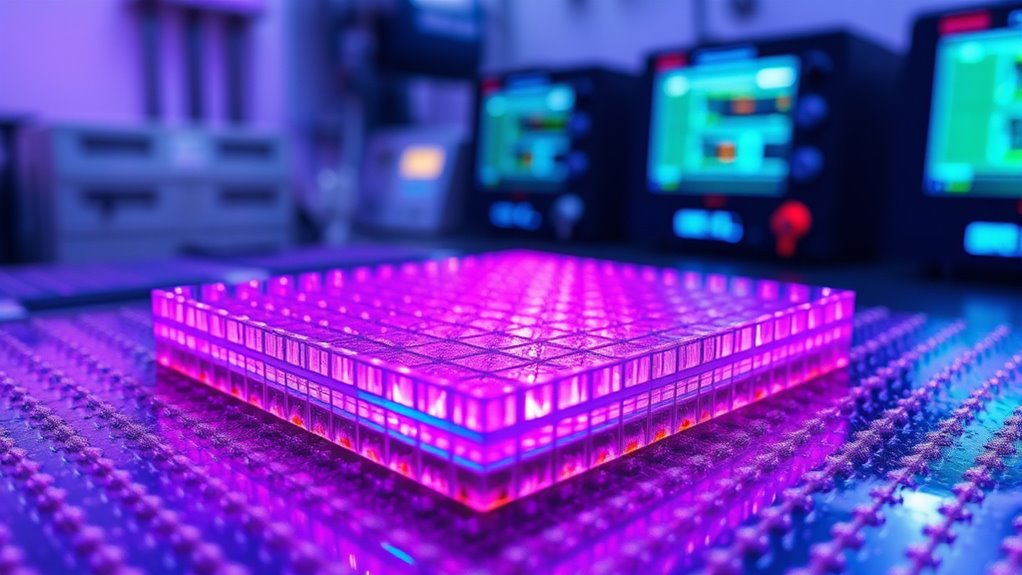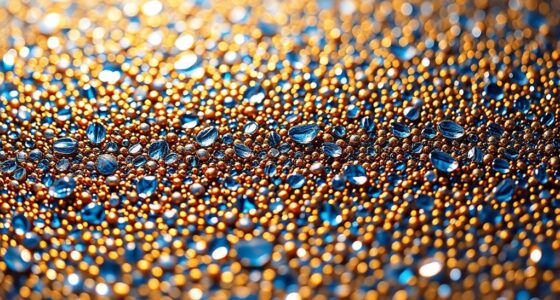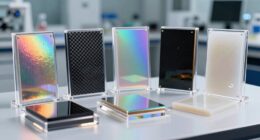Tunable bandgap nanomaterials for photovoltaics let you customize electronic properties by controlling size, doping, and surface chemistry. Quantum dots enable precise bandgap adjustments through size control, while doping shifts energy levels without changing size. Properly integrating these nanomaterials into devices improves charge transfer and reduces recombination. Combining quantum confinement with surface passivation boosts efficiency and stability. If you’re curious to learn more about how these innovations optimize solar energy devices, keep exploring these exciting techniques.
Key Takeaways
- Quantum dots enable size-dependent bandgap tuning for optimized solar spectrum absorption.
- Doping introduces impurities to modify electronic properties without altering nanomaterial size.
- Combining quantum confinement and doping allows precise control over nanomaterials’ optoelectronic characteristics.
- Surface passivation and functionalization improve stability, reduce recombination, and enhance device efficiency.
- Advanced synthesis techniques facilitate scalable production of customizable nanomaterials for enhanced photovoltaics.
Materials and Synthesis Techniques for Tunable Bandgaps

To achieve tunable bandgaps in nanomaterials for photovoltaics, researchers focus on selecting versatile materials and employing precise synthesis techniques. Quantum dots stand out because their size-dependent properties allow you to adjust the bandgap by controlling particle dimensions. Doping techniques further refine this control by introducing specific impurities into the nanomaterial, altering electronic properties and shifting the bandgap as needed. During synthesis, methods like colloidal synthesis enable precise size and composition control, ensuring consistent optical characteristics. Combining quantum dot fabrication with targeted doping allows you to customize the electronic structure effectively. These approaches provide a robust foundation for developing nanomaterials with adjustable bandgaps, paving the way for more efficient, tunable photovoltaic devices.
Strategies for Bandgap Engineering in Nanomaterials
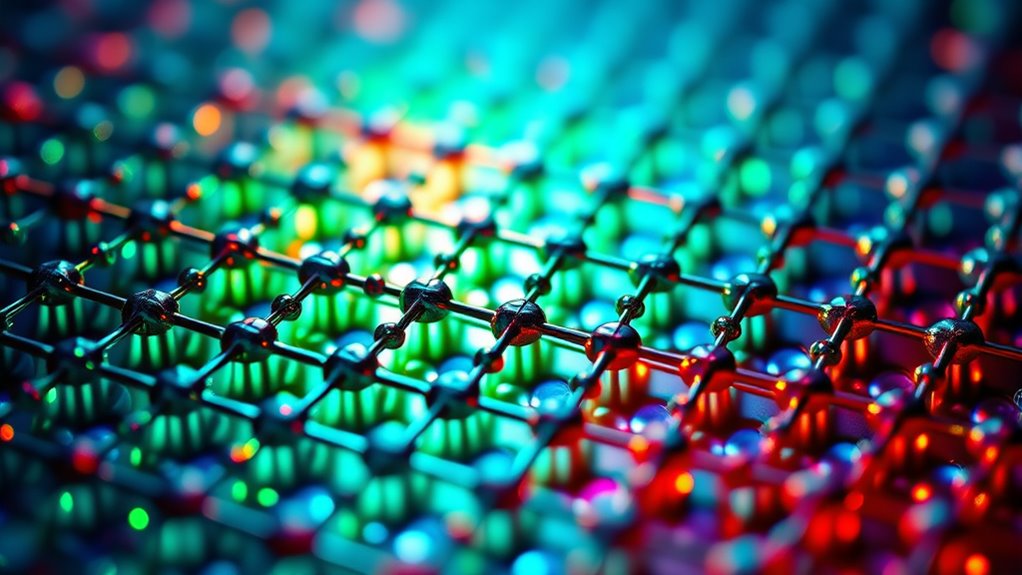
Building on the methods for tuning bandgaps through materials selection and synthesis, effective bandgap engineering strategies focus on manipulating the nanomaterial’s electronic structure directly. Quantum confinement is a key approach, where reducing particle size alters energy levels and widens or narrows the bandgap. By controlling nanocrystal dimensions, you can precisely tune optical absorption properties. Doping strategies further refine bandgap characteristics by introducing impurities that modify the charge carrier concentration and electronic states. Carefully selecting dopants enables you to shift the bandgap without changing the nanomaterial’s size or composition considerably. Combining quantum confinement with doping provides a versatile toolkit for customizing nanomaterials’ optoelectronic properties, allowing you to optimize them for specific photovoltaic applications. These strategies offer a direct route to achieve the desired bandgap adjustments essential for high-performance solar cells.
Integration of Nanomaterials Into Photovoltaic Devices
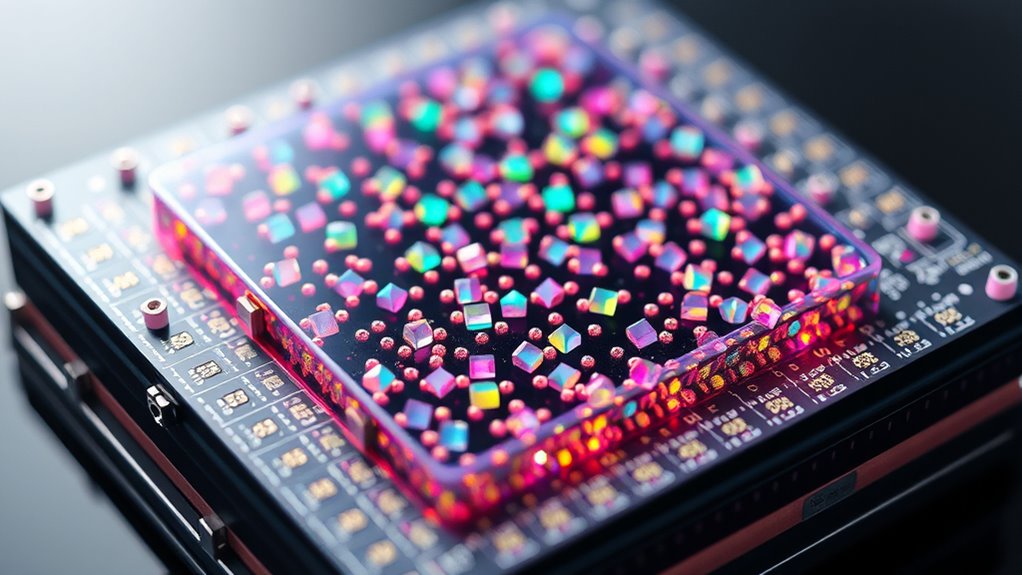
Integrating nanomaterials into photovoltaic devices requires careful design to guarantee compatibility and peak performance. Quantum confinement effects enhance charge separation and transport, but you must ensure that nanomaterials are properly interfaced with the device’s layers. Surface functionalization plays a critical role by modifying nanomaterial surfaces, improving stability, and facilitating ideal charge transfer. By tailoring surface chemistry, you can prevent recombination losses and enhance adhesion within the device architecture. Proper functionalization also helps mitigate surface traps that could impede efficiency. Balancing quantum confinement with surface modifications ensures the nanomaterials integrate seamlessly, maintaining their tunable bandgap properties while improving overall device performance. This integration process is essential for developing efficient, stable, and scalable photovoltaic systems based on nanomaterials. Additionally, considering ethical considerations such as environmental impact and safe disposal is crucial in the development and deployment of nanomaterial-based photovoltaics.
Performance Enhancement and Efficiency Optimization

Optimizing the performance of nanomaterial-based photovoltaic devices hinges on fine-tuning their properties to maximize efficiency. Quantum confinement plays a pivotal role by altering the bandgap, allowing you to better match the solar spectrum and improve light absorption. Precise control over nanomaterial size enables you to harness this effect effectively. Surface passivation also enhances performance by reducing recombination centers that trap charge carriers, boosting charge separation and collection. Applying passivation layers minimizes surface defects, leading to higher open-circuit voltages and overall device efficiency. Combining quantum confinement with effective surface passivation allows you to optimize carrier dynamics and improve the stability of nanomaterial-based solar cells. These strategies are essential for pushing the limits of photovoltaic performance and achieving higher energy conversion efficiencies.
Future Perspectives and Challenges in Solar Energy Applications
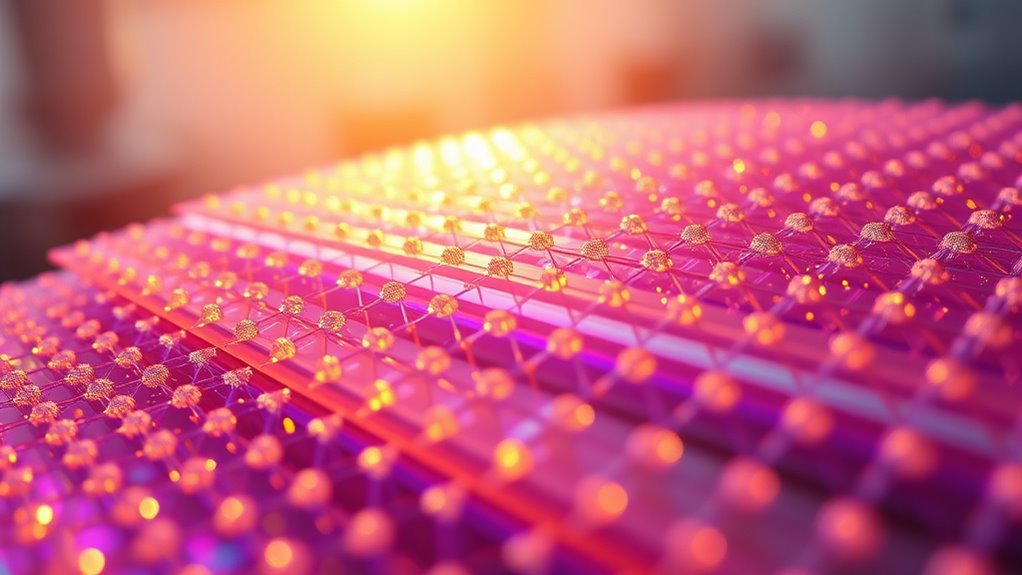
As nanomaterial-based photovoltaics continue to advance, several critical challenges and future opportunities emerge that will shape their practical deployment. Quantum confinement effects can enhance tunability but may introduce surface defects, making surface passivation essential to improve stability and efficiency. Addressing scalability and long-term durability remains essential for real-world applications. Future research should focus on optimizing synthesis techniques and integrating nanomaterials into flexible, lightweight devices. Additionally, understanding the interplay between quantum confinement and surface passivation will be key to maximizing performance. The table below highlights key challenges and prospects:
| Challenge | Future Opportunity |
|---|---|
| Managing surface defects | Advanced passivation strategies |
| Scaling production | Cost-effective manufacturing methods |
| Enhancing stability | Durable, high-performance devices |
Furthermore, employing mindfulness techniques in research environments can foster clearer thinking and innovative problem-solving approaches, which are vital for overcoming these challenges.
Frequently Asked Questions
How Do Environmental Factors Affect the Stability of Tunable Bandgap Nanomaterials?
Environmental factors can markedly impact the stability of tunable bandgap nanomaterials. You might face environmental degradation from moisture, oxygen, or UV exposure, which can cause oxidation and degrade oxide stability. These conditions weaken the nanomaterials’ structure and alter their optical properties. To guarantee long-term performance, you should consider protective coatings or encapsulation, reducing exposure to harsh environmental elements and maintaining the desired tunable properties.
What Are the Cost Implications of Large-Scale Nanomaterial Production?
You’ll find that large-scale nanomaterial production impacts costs considerably. A thorough cost analysis shows that manufacturing scalability can reduce expenses, but initial investments in specialized equipment and processes are high. As you scale up, unit costs typically decrease, making it more economically feasible. However, ongoing research into cost-effective synthesis methods remains essential to guarantee these materials can be produced affordably for widespread photovoltaic applications.
Can Tunable Bandgap Nanomaterials Be Recycled or Reused Effectively?
Imagine your nanomaterials like tiny, delicate puzzle pieces shimmering in sunlight; they can be recycled and reused, but challenges like recycling difficulties and maintaining their properties pose hurdles. Reuse strategies, such as gentle extraction and surface modifications, help preserve their tunable bandgap features. While not always straightforward, with innovative processes, you can effectively extend their lifecycle, reducing waste and maximizing the value of these advanced materials in photovoltaics.
How Do Nanomaterial Properties Influence Long-Term Device Durability?
You need to understand that nanomaterial properties directly impact your device’s durability. Their resistance to nanomaterial aging and stability under environmental stress determine how long your device lasts. Durability mechanisms like oxidation, mechanical wear, and photo-degradation can weaken nanomaterials over time. By selecting nanomaterials with robust properties and optimizing their interfaces, you can enhance long-term device performance and prevent premature failure.
Are There Any Health or Safety Concerns Related to Nanomaterial Deployment?
You should be aware that deploying nanomaterials poses health and safety concerns, especially regarding occupational exposure and environmental toxicity. Handling nanomaterials without proper precautions can lead to inhalation or skin contact, risking respiratory issues or skin irritation. Additionally, if released into the environment, they may harm ecosystems. To mitigate these risks, use protective equipment, follow safety protocols, and guarantee proper disposal practices when working with or deploying nanomaterials.
Conclusion
By exploring tunable bandgap nanomaterials, you open doors to more efficient and adaptable solar technologies. While challenges remain, your innovations can subtly transform the future of energy harvesting. Embrace these advancements, and you’ll find yourself at the forefront of a promising, ever-evolving field. With continued effort, your contributions could gently reshape how we harness the sun’s power, making sustainable energy more accessible and impactful for generations to come.
